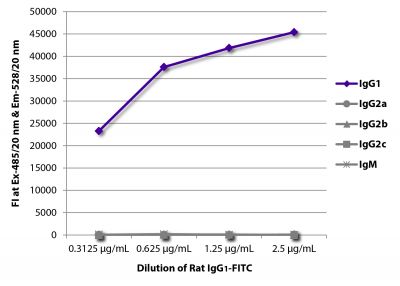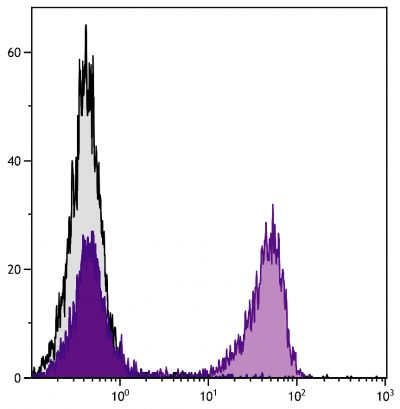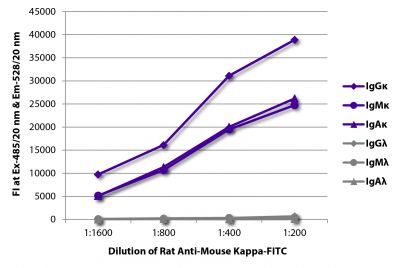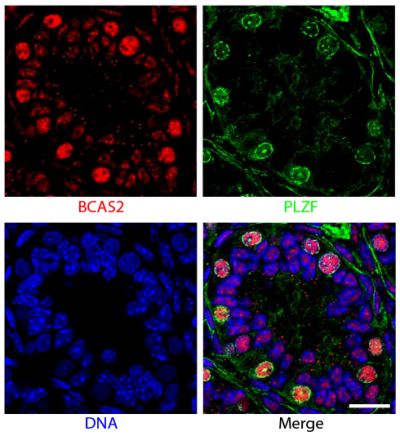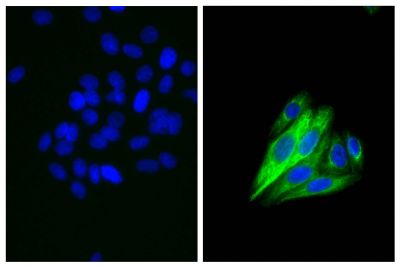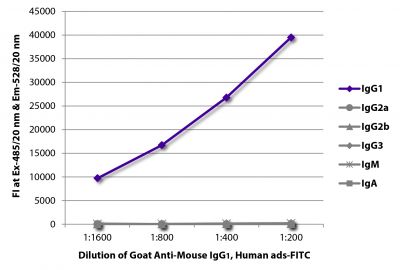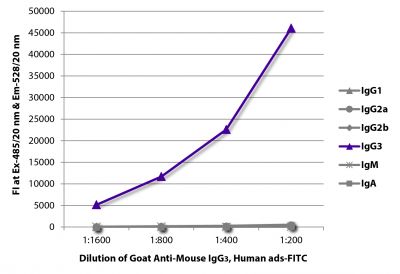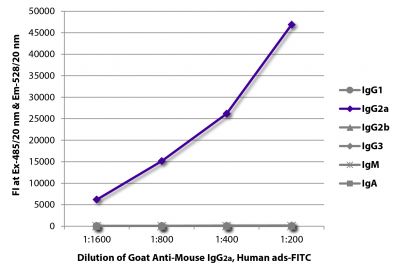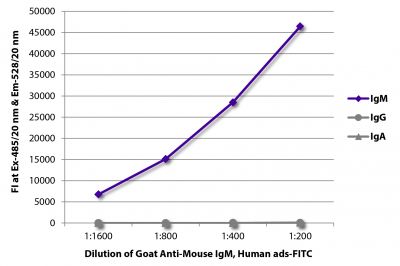Rat Anti-Mouse Kappa-FITC (187.1)
Only %1 left
Cat. No.:
1170-02,
1170-02S
FITC Anti-Mouse Kappa antibody for use in flow cytometry, immunohistochemistry, and western blot assays.
As low as
$94.00
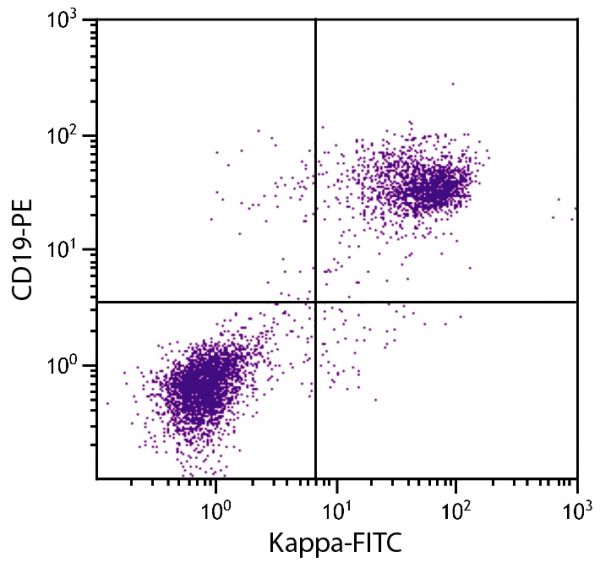

| Clone | 187.1 |
|---|---|
| Isotype | Rat (Sprague Dawley) IgG1κ |
| Isotype Control | Rat IgG1-FITC (KLH/G1-2-2) |
| Specificity | Mouse Kappa |
| Immunogen | MPC-11 immunoglobulin |
| Conjugate | FITC (Fluorescein) |
| Buffer Formulation | Phosphate buffered saline containing < 0.1% sodium azide |
| Clonality | Monoclonal |
| Concentration | 0.5 mg/mL |
| Volume | 0.2 mL or 1.0 mL |
| Recommended Storage | 2-8°C; Avoid exposure to light |
| Applications |
Flow Cytometry – Quality tested 4-15 ELISA – Quality tested 2,3 FLISA – Quality tested Immunohistochemistry-Frozen Sections – Reported in literature 16 Western Blot-Non-Reducing – Reported in literature 4,17,18 Immunoprecipitation – Reported in literature 19 Purification – Reported in literature 20,21 Costimulation – Reported in literature 22 |
| RRID Number | AB_2794664 |
| Gene ID |
243469 (Mouse) |
| Gene ID Symbol |
Igk (Mouse) |
| Gene ID Aliases | kappa |
| UniProt ID |
P01837 (Mouse) |
| UniProt Name |
IGKC_MOUSE (Mouse) |
Documentation
Certificate of Analysis Lookup
Enter the Catalog Number and Lot Number for the Certificate of Analysis you wish to view
- 1. Yelton DE, Desaymard C, Scharff MD. Use of monoclonal anti-mouse immunoglobulin to detect mouse antibodies. Hybridoma. 1981;1:5-11. (Immunogen)
- 2. Förster M, Raposo B, Ekman D, Klaczkowska D, Popovic M, Nandakumar KS, et al. Genetic control of antibody production during collagen-induced arthritis development in heterogeneous stock mice. Arthritis Rheum. 2012;64:3594-603. (ELISA)
- 3. Raposo B, Dobritzsch D, Ge C, Ekman D, Xu B, Lindh I, et al. Epitope-specific antibody response is controlled by immunoglobulin VH polymorphisms. J Exp Med. 2014;211:405-11. (ELISA)
- 4. Nakamura T, Kubagawa H, Cooper MD. Heterogeneity of immunoglobulin-associated molecules on human B cells identified by monoclonal antibodies. Proc Natl Acad Sci USA. 1992;89:8522-6. (FC, WB)
- 5. Bertocci B, De Smet A, Berek C, Weill J, Reynaud C. Immunoglobulin κ light chain gene rearrangement is impaired in mice deficient for DNA polymerase mu. Immunity. 2003;19:203-11. (FC)
- 6. Heltemes-Harris L, Liu X, Manser T. Progressive surface B cell antigen receptor down-regulation accompanies efficient development of antinuclear antigen B cells to mature, follicular phenotype. J Immunol. 2004;172:823-33. (FC)
- 7. Wang Y, Carter RH. CD19 regulates B cell maturation, proliferation, and positive selection in the FDC zone of murine splenic germinal centers. Immunity. 2005;22:749-61. (FC)
- 8. Vettermann C, Lutz J, Selg M, Bösl M, Jäck H. Genomic suppression of murine B29/Ig-β promoter-driven transgenes. Eur J Immunol. 2006;36:3324-33. (FC)
- 9. Lindsley RC, Thomas M, Srivastava B, Allman D. Generation of peripheral B cells occurs via two spatially and temporally distinct pathways. Blood. 2007;109:2521-8. (FC)
- 10. Bai L, Chen Y, He Y, Dai X, Lin X, Wen R, et al. Phospholipase Cγ2 contributes to light-chain gene activation and receptor editing. Mol Cell Biol. 2007;27:5957-67. (FC)
- 11. Liu X, Shen S, Manser T. Influence of B cell antigen receptor expression level on pathways of B cell tolerance induction. J Immunol. 2009;182:398-407. (FC)
- 12. Gross AJ, Lyandres JR, Panigrahi AK, Prak ET, DeFranco AL. Developmental acquisition of the Lyn-CD22-SHP-1 inhibitory pathway promotes B cell tolerance. J Immunol. 2009;182:5382-92. (FC)
- 13. Stumhofer JS, Tait ED, Quinn WJ 3rd, Hosken N, Spudy B, Goenka R, et al. A role for IL-27p28 as an antagonist of gp130-mediated signaling. Nat Immunol. 2010;11:1119-26. (FC)
- 14. Corrah TW, Goonetilleke N, Kopycinski J, Deeks SG, Cohen MS, Borrow P, et al. Reappraisal of the relationship between the HIV-1-protective single-nucleotide polymorphism 35 kilobases upstream of the HLA-C gene and surface HLA-C expression. J Virol. 2011;85:3367-74. (FC)
- 15. Knoll M, Yanagisawa Y, Simmons S, Engels N, Wienands J, Melchers F, et al. The non-Ig parts of the VpreB and λ5 proteins of the surrogate light chain play opposite roles in the surface representation of the precursor B cell receptor. J Immunol. 2012;188:6010-7. (FC)
- 16. Nandakumar KS, Collin M, Olsén A, Nimmerjahn F, Blom AM, Ravetch JV, et al. Endoglycosidase treatment abrogates IgG arthritogenicity: importance of IgG glycosylation in arthritis. Eur J Immunol. 2007;37:2973-82. (IHC-FS)
- 17. Naumann I, Kappler R, von Schweinitz D, Debatin K, Fulda S. Bortezomib primes neuroblastoma cells for TRAIL-induced apoptosis by linking the death receptor to the mitochondrial pathway. Clin Cancer Res. 2011;17:3204-18. (WB-NR)
- 18. Unterkircher T, Cristofanon S, Vellanki SH, Nonnenmacher L, Karpel-Massler G, Wirtz CR, et al. Bortezomib primes glioblastoma, including glioblastoma stem cells, for TRAIL by increasing tBid stability and mitochondrial apoptosis. Clin Cancer Res. 2011;17:4019-30. (WB-NR)
- 19. Campbell KS, Cambier JC. B lymphocyte antigen receptors (mIg) are non-covalently associated with a disulfide linked, inducibly phosphorylated glycoprotein complex. EMBO J. 1990;9:441-8. (IP)
- 20. Vainio O, Dunon D, Aïssi F, Dangy J, McNagny KM, Imhof BA. HEMCAM, an adhesion molecule expressed by c-kit+ hemopoietic progenitors. J Cell Biol. 1996;135:1655-68. (Purification)
- 21. Tunheim G, Schjetne KW, Fredriksen AB, Sandlie I, Bogen B. Human CD14 is an efficient target for recombinant immunoglobulin vaccine constructs that deliver T cell epitopes. J Leukoc Biol. 2005;77:303-10. (Purification)
- 22. Kisielow M, Kisielow J, Capoferri-Sollami G, Karjalainen K. Expression of lymphocyte activation gene 3 (LAG-3) on B cells is induced by T cells. Eur J Immunol. 2005;35:2081-8. (Costim)
See All References


